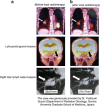Immunogenic tumor cell death induced by chemoradiotherapy: molecular mechanisms and a clinical translation
- PMID: 23788045
- PMCID: PMC3702303
- DOI: 10.1038/cddis.2013.207
Immunogenic tumor cell death induced by chemoradiotherapy: molecular mechanisms and a clinical translation
Abstract
Chemoradiotherapy can induce immunogenic cell death, triggering danger signals such as high-mobility group box 1 protein, and resulting in T-cell immunity. This concept can potentially be harnessed for clinical therapy to enhance tumor-specific immunity. There is however limited information to translate this theory directly in a clinical setting. In this review, we will discuss and summarize molecular and cellular mechanisms underlying immunogenic tumor cell death induced by chemoradiotherapy, with emphasis on a clinical translation.
Figures



Similar articles
-
Immunogenic cancer cell death: a key-lock paradigm.Curr Opin Immunol. 2008 Oct;20(5):504-11. doi: 10.1016/j.coi.2008.05.007. Epub 2008 Jun 23. Curr Opin Immunol. 2008. PMID: 18573340 Review.
-
Cell death induced by cytotoxic CD8+ T cells is immunogenic and primes caspase-3-dependent spread immunity against endogenous tumor antigens.J Immunother Cancer. 2020 Apr;8(1):e000528. doi: 10.1136/jitc-2020-000528. J Immunother Cancer. 2020. PMID: 32241808 Free PMC article.
-
Tumor cell lysates as immunogenic sources for cancer vaccine design.Hum Vaccin Immunother. 2014;10(11):3261-9. doi: 10.4161/21645515.2014.982996. Hum Vaccin Immunother. 2014. PMID: 25625929 Free PMC article. Review.
-
Immunogenic tumor cell death induced by chemoradiotherapy in patients with esophageal squamous cell carcinoma.Cancer Res. 2012 Aug 15;72(16):3967-76. doi: 10.1158/0008-5472.CAN-12-0851. Epub 2012 Jun 14. Cancer Res. 2012. PMID: 22700877
-
Immunogenic cancer cell death selectively induced by near infrared photoimmunotherapy initiates host tumor immunity.Oncotarget. 2017 Feb 7;8(6):10425-10436. doi: 10.18632/oncotarget.14425. Oncotarget. 2017. PMID: 28060726 Free PMC article.
Cited by
-
Innate immune checkpoints for cancer immunotherapy: expanding the scope of non T cell targets.Ann Transl Med. 2020 Aug;8(16):1031. doi: 10.21037/atm-20-1816. Ann Transl Med. 2020. PMID: 32953831 Free PMC article. No abstract available.
-
Radiation therapy enhanced therapeutic efficacy of anti-PD1 against gastric cancer.J Radiat Res. 2020 Nov 16;61(6):851-859. doi: 10.1093/jrr/rraa077. J Radiat Res. 2020. PMID: 32960261 Free PMC article.
-
Immunogenic chemotherapy: Dose and schedule dependence and combination with immunotherapy.Cancer Lett. 2018 Apr 10;419:210-221. doi: 10.1016/j.canlet.2018.01.050. Cancer Lett. 2018. PMID: 29414305 Free PMC article. Review.
-
Efficacy and safety analysis of immune checkpoint inhibitor rechallenge therapy in locally advanced and advanced non-small cell lung cancer: a retrospective study.J Thorac Dis. 2024 Mar 29;16(3):1787-1803. doi: 10.21037/jtd-23-1767. Epub 2024 Mar 19. J Thorac Dis. 2024. PMID: 38617775 Free PMC article.
-
Induction of Immunogenic Cell Death in Lymphoma Cells by Wharton's Jelly Mesenchymal Stem Cell Conditioned Medium.Stem Cell Rev Rep. 2017 Dec;13(6):801-816. doi: 10.1007/s12015-017-9767-8. Stem Cell Rev Rep. 2017. PMID: 28918474
References
-
- Ishikura S, Nihei K, Ohtsu A, Boku N, Hironaka S, Mera K, et al. Long-term toxicity after definitive chemoradiotherapy for squamous cell carcinoma of the thoracic esophagus. J Clin Oncol. 2003;21:2697–2702. - PubMed
-
- de Manzoni G, Pedrazzani C, Laterza E, Pasini F, Grandinetti A, Bernini M, et al. Induction chemoradiotherapy for squamous cell carcinoma of the thoracic esophagus: impact of increased dosage on long-term results. Ann Thorac Surg. 2005;80:1176–1183. - PubMed
-
- Polischouk AG, Grenman R, Granath F, Lewensohn R. Radiosensitivity of human squamous carcinoma cell lines is associated with amount of spontaneous DNA strand breaks. Int J Cancer. 2001;96:43–53. - PubMed
-
- Mole RH. Whole body irradiation; radiobiology or medicine. Br J Radiol. 1953;26:234–241. - PubMed
Publication types
MeSH terms
Substances
LinkOut - more resources
Full Text Sources
Other Literature Sources

